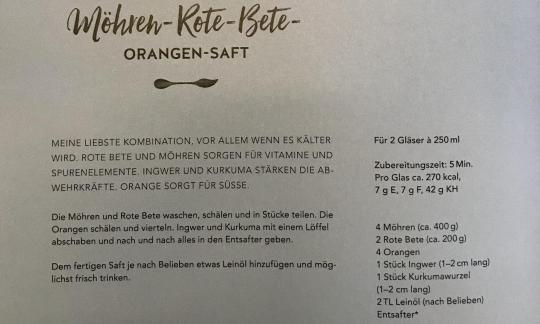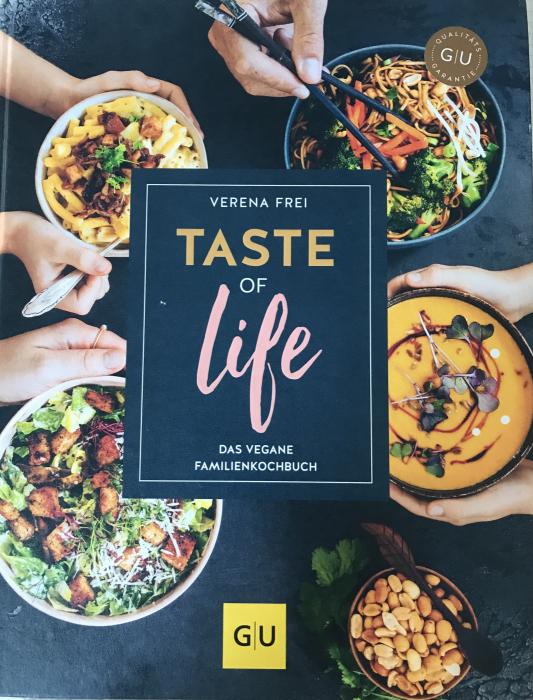Carrot-beetroot-orange juice with ginger and turmeric
raw-vegan
Ingredients (for servings, )
| juice base | |
|---|---|
| 4 | Carrots (carrots), raw (organic?) (8.6 oz) |
| 14 oz | Beetroot, raw (organic?) |
| ⅛ oz | Oranges, raw, (organic?) |
| To refine (optional) | |
| 2 cm | Ginger, raw (organic?) (0.76 oz) |
| 2 cm | Turmeric, fresh (raw, organic?) (0.22 oz) |
| Optional | |
| ½ tbsp | Linseed oil (linseed oil, flax oil), cold pressed (raw?, organic?) (0.24 oz) |
Equipment
- juicer
- vegetable peeler
Type of preparation
- chop or grind
- food preparation without heating
- juice
- peel
Preparation
Wash the carrots and beetroot, peel them and cut them into pieces. Peel the oranges and cut them into quarters. Scrape off the ginger and turmeric with a spoon and gradually add everything to the juicer.
If you use organic vegetables, you do not need to remove the peels. The original recipe calls for 1-2 cm of ginger and turmeric each for 2 portions.
Add some linseed oil to the finished juice as desired and drink it as fresh as possible.
The author recommended 2 teaspoons of linseed oil (optional) for 2 servings.
The indicated amount for 2 portions is sufficient for 2 glasses of 250 ml each.
|
Nutritional Information per person
Convert per 100g
|
2000 kcal | |
|---|---|---|
| Energy | 177 kcal | 8.9% |
| Fat/Lipids | 4.1 g | 5.9% |
| Saturated Fats | 0.43 g | 2.2% |
| Carbohydrates (inc.dietary fiber) | 33 g | 12.3% |
| Sugars | 20 g | 21.9% |
| Fiber | 9.4 g | 37.5% |
| Protein/Albumin | 4.6 g | 9.2% |
| Cooking Salt (Na:241.8 mg) | 614 mg | 25.6% |
| Essential micronutrients with the highest proportions | per person | 2000 kcal | |
|---|---|---|---|
| Vit | Vitamin A, as RAE | 1'023 µg | 128.0% |
| Vit | Vitamin B9, B11 (Folate, as the active form of folic acid) | 243 µg | 121.0% |
| Fat | Alpha-Linolenic acid; ALA; 18:3 omega-3 | 1.8 g | 92.0% |
| Elem | Potassium, K | 1'089 mg | 54.0% |
| Min | Manganese, Mn | 0.92 mg | 46.0% |
| Prot | Threonine (Thr, T, irreversibly transaminated) | 0.33 g | 36.0% |
| Sodium, Na | 242 mg | 30.0% | |
| Vit | Vitamin C (ascorbic acid) | 19 mg | 24.0% |
| Min | Copper, Cu | 0.23 mg | 23.0% |
| Vit | Vitamin B6 (pyridoxine) | 0.32 mg | 23.0% |
Detailed Nutritional Information per Person for this Recipe
The majority of the nutritional information comes from the USDA (US Department of Agriculture). This means that the information for natural products is often incomplete or only given within broader categories, whereas in most cases products made from these have more complete information displayed.
If we take flaxseed, for example, the important essential amino acid ALA (omega-3) is only included in an overarching category whereas for flaxseed oil ALA is listed specifically. In time, we will be able to change this, but it will require a lot of work. An “i” appears behind ingredients that have been adjusted and an explanation appears when you hover over this symbol.
For Erb Muesli, the original calculations resulted in 48 % of the daily requirement of ALA — but with the correction, we see that the muesli actually covers >100 % of the necessary recommendation for the omega-3 fatty acid ALA. Our goal is to eventually be able to compare the nutritional value of our recipes with those that are used in conventional western lifestyles.
| Essential fatty acids | per person | 2000 kcal |
|---|---|---|
| Alpha-Linolenic acid; ALA; 18:3 omega-3 | 1.8 g | 92.0% |
| Linoleic acid; LA; 18:2 omega-6 | 0.75 g | 7.0% |
| Essential amino acids | per person | 2000 kcal |
|---|---|---|
| Threonine (Thr, T, irreversibly transaminated) | 0.33 g | 36.0% |
| Tryptophan (Trp, W) | 0.06 g | 22.0% |
| Isoleucine (Ile, I) | 0.20 g | 16.0% |
| Lysine (Lys, K, irreversibly transaminated) | 0.25 g | 13.0% |
| Valin (Val, V) | 0.21 g | 13.0% |
| Leucine (Leu, L) | 0.27 g | 11.0% |
| Phenylalanine (Phe, F) | 0.17 g | 11.0% |
| Methionine (Met, M) | 0.06 g | 7.0% |
| Vitamins | per person | 2000 kcal |
|---|---|---|
| Vitamin A, as RAE | 1'023 µg | 128.0% |
| Vitamin B9, B11 (Folate, as the active form of folic acid) | 243 µg | 121.0% |
| Vitamin C (ascorbic acid) | 19 mg | 24.0% |
| Vitamin B6 (pyridoxine) | 0.32 mg | 23.0% |
| Vitamin K | 17 µg | 22.0% |
| Vitamin B1 (Thiamine) | 0.15 mg | 14.0% |
| Vitamin B3 (Niacin) | 2.0 mg | 12.0% |
| Vitamin B7 (Biotin, ex vitamin H) | 6.1 µg | 12.0% |
| Vitamin B2 (Riboflavin) | 0.16 mg | 11.0% |
| Vitamin B5 (Pantothenic acid) | 0.67 mg | 11.0% |
| Vitamin E, as a-TEs | 0.93 mg | 8.0% |
| Essential macroelements (macronutrients) | per person | 2000 kcal |
|---|---|---|
| Potassium, K | 1'089 mg | 54.0% |
| Sodium, Na | 242 mg | 30.0% |
| Magnesium, Mg | 68 mg | 18.0% |
| Phosphorus, P | 127 mg | 18.0% |
| Calcium, Ca | 76 mg | 9.0% |
| Essential trace elements (micronutrients) | per person | 2000 kcal |
|---|---|---|
| Manganese, Mn | 0.92 mg | 46.0% |
| Copper, Cu | 0.23 mg | 23.0% |
| Iron, Fe | 2.1 mg | 15.0% |
| Zinc, Zn | 1.1 mg | 11.0% |
| Selenium, Se | 1.6 µg | 3.0% |
| Iod, I (Jod, J) | 4.5 µg | 3.0% |
| Fluorine, F | 3.9 µg | < 0.1% |
GRÄFE UND UNZER Verlag GmbH / Ganzke Verlagsgruppe, Verena Frei
Raw recipes 9 (1), Cooked recipes 66 (2)
Additional photos (5)
Taste of Life - the vegan family cookbook contains international, everyday recipes. For families and those who prefer classic dishes.
Since this book is written in German, a description is omitted here. If you are interested, please switch to German in the menu.
The carrot-beetroot-orange juice with ginger and turmeric not only tastes good, but is also healthy.
Serving size: The indicated amount for 2 servings is sufficient for 2 glasses of 250 ml each.
Nutrient profile: One portion of this recipe covers three times the average daily requirement of vitamin C and far more than the daily requirement of folic acid. Vitamin A is completely covered and omega-3 fatty acids are almost 100% covered. The ratio of omega-6 to omega-3 fatty acids is very good at 1:2 thanks to the linseed oil.
Carrots: Carrots are particularly rich in carotene, a precursor to vitamin A, which gives them their typical orange color. Vitamin A is important for our eyesight, among other things, but also for the immune system.
Beetroot: Beetroot is a healthy vegetable, partly due to its high folic acid content, and can be eaten cooked or raw.
Ginger: Ginger has an aromatic smell and a sharp, spicy taste, which is due to the (spicy) substance gingerol, which is said to have anti-carcinogenic and anti-inflammatory effects. The substances borneol and cineol give ginger its digestive, antiemetic, appetite-stimulating and circulation-stimulating properties. The ginger rhizome is used in cooking in fresh, dried or ground form.
Turmeric: Fresh turmeric has a peppery, slightly spicy taste.
Linseed and linseed oil: Linseed is the seed of the flax plant (common flax, Linum usitatissimum). Linseed has a slightly nutty taste and a fat content of around 40%. Half of this consists of alpha-linolenic acid, a polyunsaturated omega-3 fatty acid. Therefore, linseed oil has the highest omega-3 fatty acid concentration of all known vegetable oils.
Avoid discoloration: Since turmeric and beetroot are very color-intensive, it is advisable to wear disposable gloves when processing them. Permanent discoloration can occur, especially on white kitchen appliances.
Beetroot: People who are prone to the formation of kidney stones, such as Crohn's disease patients, should only consume beetroot in moderation due to its high oxalic acid content.
Storing turmeric: Turmeric is best stored in a dark place, otherwise you can expect a loss in color and taste.






